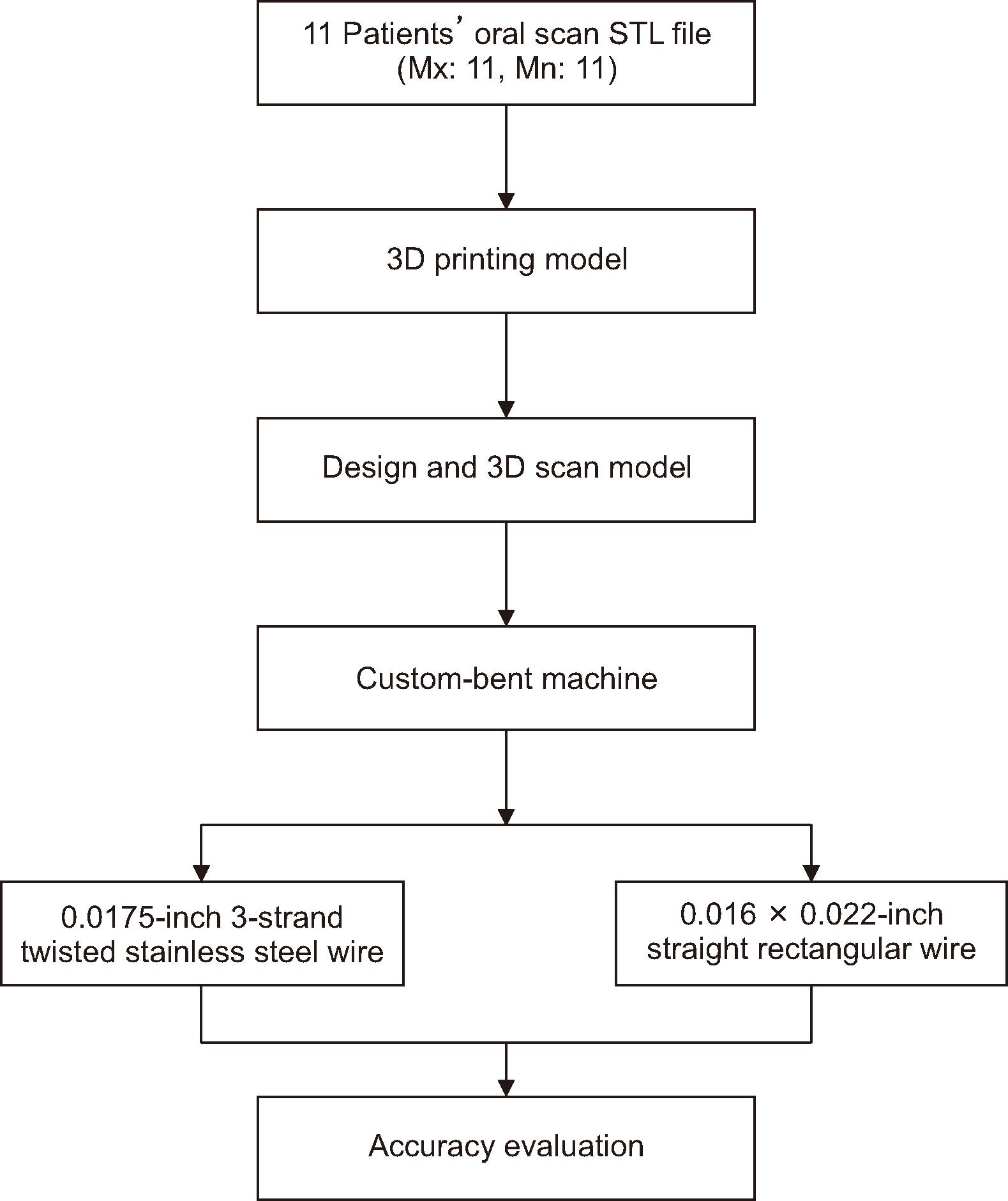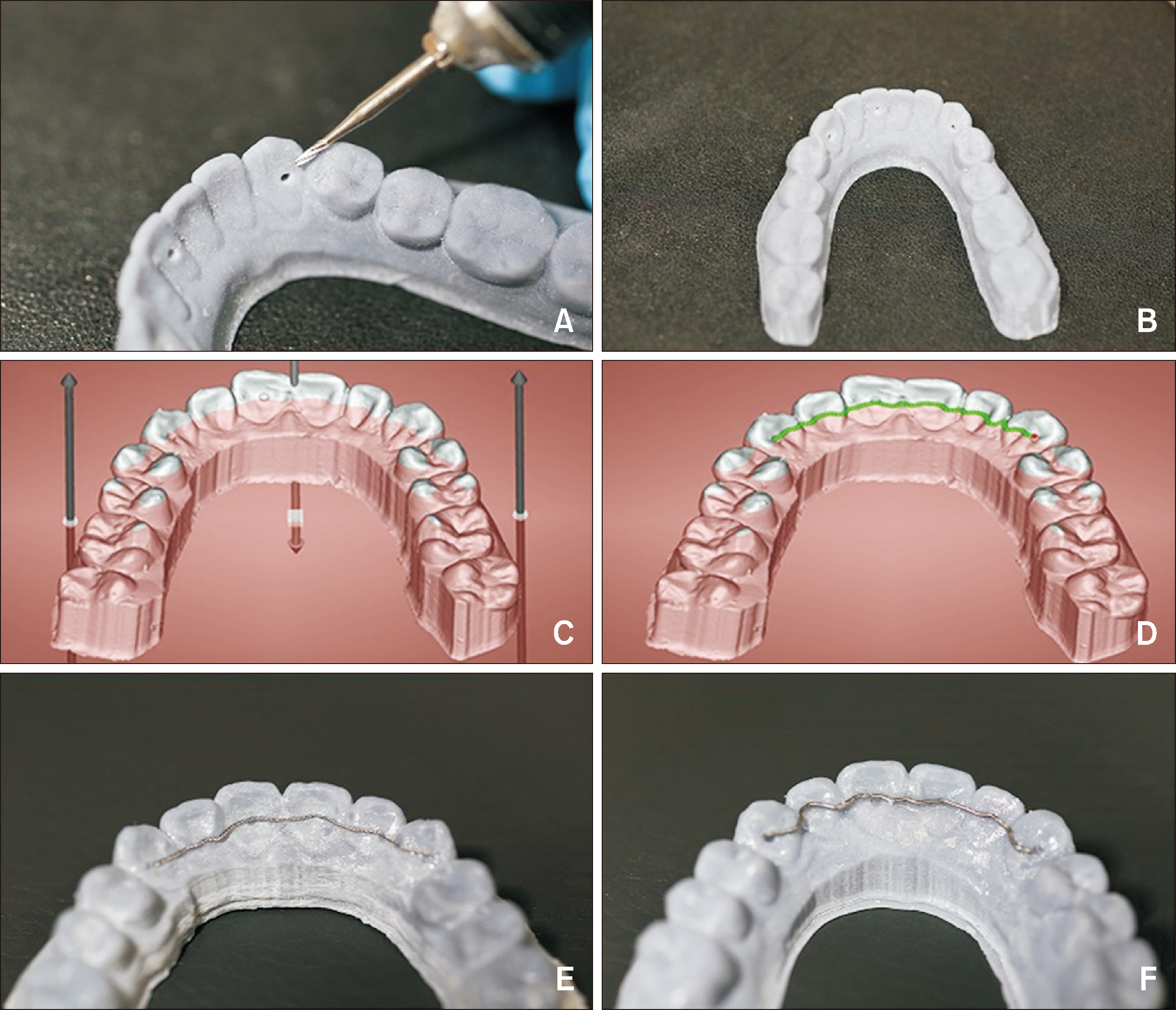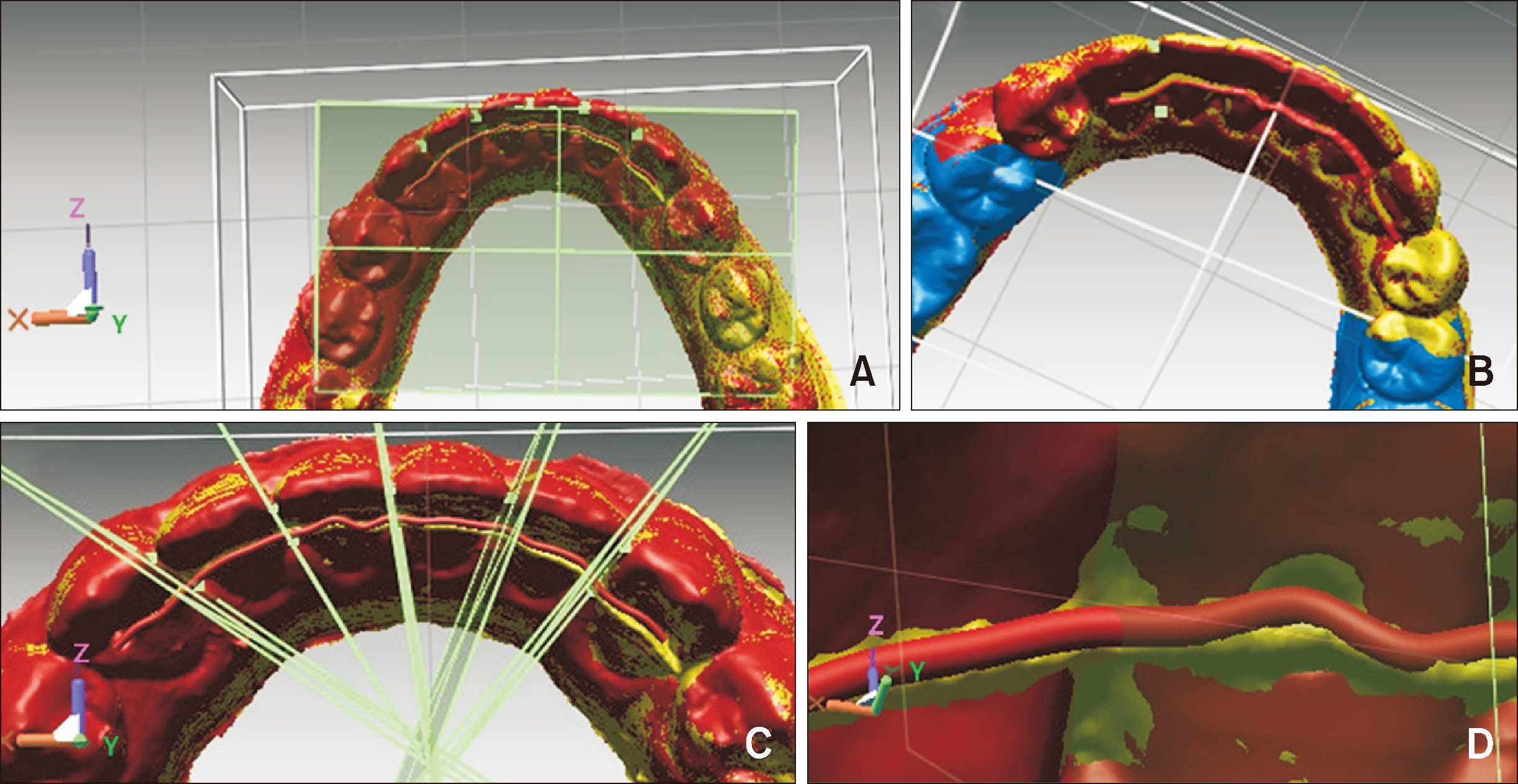Korean J Orthod.
2024 Jul;54(4):257-263. 10.4041/kjod24.078.
Accuracy of lingual fixed retainers fabricated using a CAD/CAM bending machine
- Affiliations
-
- 1Department of Orthodontics, School of Dentistry, Kyung Hee University, Seoul, Korea
- KMID: 2558295
- DOI: http://doi.org/10.4041/kjod24.078
Abstract
Objective
Lingual fixed retainers, made from 0.0175-inch 3-strand twisted stainless steel wire (TW) and 0.016 × 0.022-inch straight rectangular wire (RW), are generally used in clinical practice. This study aimed to calculate their accuracy by comparing the discrepancy between computer-aided customized retainers made from these two types of wires.
Methods
Eleven orthodontic patients were selected, resulting in 22 maxillary and mandibular threedimensional printing dental models. Two types of lingual fixed retainers were bonded from canine to canine. To determine the accuracy, five points were chosen for each model, resulting in 110 selected points. The absolute values of the distances on the x-, y-, and z-axes were measured to compare the accuracy of the two types of computer-aided retainers.
Results
The accuracy of the two types of retainers did not differ significantly in the x- and z-axes, but only in the y-axis (P < 0.01), where RW-fixed retainers exhibited a slightly but significantly increased distance compared to the TW.
Conclusions
Both types of retainers showed high accuracy; however, RW had a slight but statistically significant difference along the y-axis compared with TW. This type of computer-aided design/computer-aided manufacturing bending machine is limited to two dimensions, and the dental arch is curved. Therefore, RW may require slight manual adjustment by the practitioner after manufacturing.
Keyword
Figure
Reference
-
References
1. Moyers RE. 1988. Handbook of orthodontics. 4th ed. Year Book Medical Publishers;Chicago: 577. https://search.worldcat.org/ko/title/17200097. DOI: 10.1016/0889-5406(88)90042-x.2. Thilander B. 2000; Biological basis for orthodontic relapse. Semin Orthod. 6:195–205. https://doi.org/10.1053/sodo.2000.8085. DOI: 10.1053/sodo.2000.8085.3. Yu Y, Sun J, Lai W, Wu T, Koshy S, Shi Z. 2013; Interventions for managing relapse of the lower front teeth after orthodontic treatment. Cochrane Database Syst Rev. 2013:CD008734. https://doi.org//10.1002/14651858.CD008734.pub2. DOI: 10.1002/14651858.CD008734.pub2. PMID: 24014170. PMCID: PMC10793711.
Article4. Storey M, Forde K, Littlewood SJ, Scott P, Luther F, Kang J. 2018; Bonded versus vacuum-formed retainers: a randomized controlled trial. Part 2: periodontal health outcomes after 12 months. Eur J Orthod. 40:399–408. https://doi.org/10.1093/ejo/cjx059. DOI: 10.1093/ejo/cjx059. PMID: 29059293.
Article5. Pratt MC, Kluemper GT, Lindstrom AF. 2011; Patient compliance with orthodontic retainers in the postretention phase. Am J Orthod Dentofacial Orthop. 140:196–201. https://doi.org/10.1016/j.ajodo.2010.02.035. DOI: 10.1016/j.ajodo.2010.02.035. PMID: 21803257.
Article6. Devi S, Jain RK, Balasubramaniam A. 2022; Comparative evaluation of patient satisfaction following the use of two different orthodontic removable retainers: a prospective randomized controlled trial. J Int Oral Health. 14:370–6. https://doi.org/10.4103/JIOH.JIOH_17_22. DOI: 10.4103/JIOH.JIOH_17_22.
Article7. Bearn DR. 1995; Bonded orthodontic retainers: a review. Am J Orthod Dentofacial Orthop. 108:207–13. https://doi.org/10.1016/s0889-5406(95)70085-4. DOI: 10.1016/S0889-5406(95)70085-4. PMID: 7625397.
Article8. Zachrisson BU. 1982; The bonded lingual retainer and multiple spacing of anterior teeth. Swed Dent J Suppl. 15:247–55. https://pubmed.ncbi.nlm.nih.gov/6963780/.9. Engeler OG, Dalstra M, Arnold DT, Steineck M, Verna C. 2021; In vitro comparison of the torsional load transfer of various commercially available stainless-steel wires used for fixed retainers in orthodontics. J Orthod. 48:118–26. https://doi.org/10.1177/1465312520972402. DOI: 10.1177/1465312520972402. PMID: 33231109.10. Rahimi H, Albright DA, Hughes JA, Dutra V, Turkkahraman H. 2022; Three-dimensional analysis of the posttreatment displacements of mandibular anterior teeth with rigid and flexible lingual retainers. Am J Orthod Dentofacial Orthop. 161:628–37. https://doi.org/10.1016/j.ajodo.2020.11.044. DOI: 10.1016/j.ajodo.2020.11.044. PMID: 34953659.
Article11. Kartal Y, Kaya B, Polat-Özsoy Ö. 2021; Comparative evaluation of periodontal effects and survival rates of memotain and five-stranded bonded retainers: a prospective short-term study. J Orofac Orthop. 82:32–41. https://doi.org/10.1007/s00056-020-00243-5. DOI: 10.1007/s00056-020-00243-5. PMID: 32780168.
Article12. Kravitz ND, Grauer D, Schumacher P, Jo YM. 2017; Memotain: a CAD/CAM nickel-titanium lingual retainer. Am J Orthod Dentofacial Orthop. 151:812–5. https://doi.org/10.1016/j.ajodo.2016.11.021. DOI: 10.1016/j.ajodo.2016.11.021. PMID: 28364905.
Article13. Namura Y, Pullisaar H, Holm HV, Syverud M, Mulic A, Vandevska-Radunovic V. 2024; Elemental composition, corrosion resistance and mechanical properties of computer-aided design and computer-aided manufacturing fixed retainers versus conventional fixed retainers. J Oral Sci. 66:107–10. https://doi.org/10.2334/josnusd.23-0303. DOI: 10.2334/josnusd.23-0303. PMID: 38403676.14. Shim H, Foley P, Bankhead B, Kim KB. 2022; Comparative assessment of relapse and failure between CAD/CAM stainless steel and standard stainless steel fixed retainers in orthodontic retention patientss: a randomized controlled trial. Angle Orthod. 92:87–94. https://doi.org/10.2319/121720-1015.1. DOI: 10.2319/121720-1015.1. PMID: 34464438. PMCID: PMC8691474.
Article15. Kang SH, Kwon JS, Chung CJ, Cha JY, Lee KJ. 2022; Accuracy and stability of computer-aided customized lingual fixed retainer: a pilot study. Prog Orthod. 23:39. https://doi.org/10.1186/s40510-022-00436-1. DOI: 10.1186/s40510-022-00436-1. PMID: 36404385. PMCID: PMC9676156. PMID: 20d9a6b75e4040108f057940601e94a5.16. Wolf M, Schumacher P, Jäger F, Wego J, Fritz U, Korbmacher-Steiner H, et al. 2015; Novel lingual retainer created using CAD/CAM technology. J Orofac Orthop. 76:164–74. https://doi.org/10.1007/s00056-014-0279-8. DOI: 10.1007/s00056-014-0279-8. PMID: 25744094.17. Alrawas MB, Kashoura Y, Tosun Ö, Öz U. 2021; Comparing the effects of CAD/CAM nickel-titanium lingual retainers on teeth stability and periodontal health with conventional fixed and removable retainers: a randomized clinical trial. Orthod Craniofac Res. 24:241–50. https://doi.org/10.1111/ocr.12425. DOI: 10.1111/ocr.12425. PMID: 32865325.
Article18. Çokakoğlu S, Adanur-Atmaca R, Çakır M, Öztürk F. 2024; Stability and failure rate during 3 years of fixed retention: a follow-up of an randomized clinical trial on adolescents with four different lingual retainers. Orthod Craniofac Res. 27:251–8. https://doi.org/10.1111/ocr.12714. DOI: 10.1111/ocr.12714. PMID: 37786933.
Article19. Littlewood SJ, Kandasamy S, Huang G. 2017; Retention and relapse in clinical practice. Aust Dent J. 62:51–7. https://doi.org/10.1111/adj.12475. DOI: 10.1111/adj.12475. PMID: 28297088.
Article20. Roussarie F, Douady G. 2018; Unwanted tooth movement produced by the bonded retention wire: the "wire syndrome," observations, theories, clinical consequences: second part. J Dentofacial Anom Orthod. 21:503. https://doi.org/10.1051/odfen/2018133. DOI: 10.1051/odfen/2018133.
Article
- Full Text Links
- Actions
-
Cited
- CITED
-
- Close
- Share
- Similar articles
-
- Innovative customized CAD/CAM nickel-titanium lingual retainer versus standard stainless-steel lingual retainer: A randomized controlled trial
- Comparison of occusal aspects in monolithic zirconia crown before and after occlusal adjustment during intraoral try-in: a case report
- Marginal fit of three-unit zirconia anterior fixed dental prostheses fabricated using CAD/CAM and MAD/MAM system
- Color stability of fully- and pre-crystalized chair-side CAD-CAM lithium disilicate restorations after required and additional sintering processes
- CAD-CAM fabricated Milled-bar and Implant Overdenture after Reconstruction with a Fibular Free Flap: A Clinical Report




